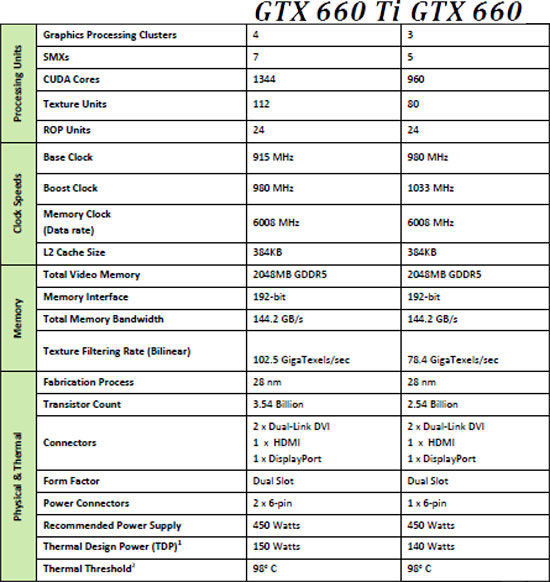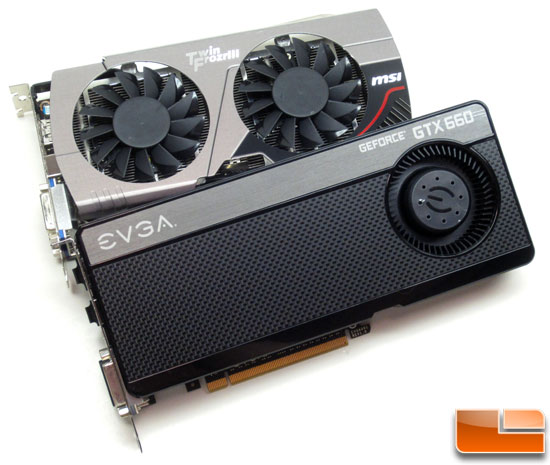NVIDIA GeForce GTX 660 Video Card Review w/ MSI and EVGA
Final Thoughts and Conclusions
The launch of the NVIDIA GeForce GTX 660 breaths new life to the ~$200 video card segment and that is great news for gamers and enthusiasts. It also brings the latest NVIDIA microarchitecture (Kepler) down to price points that are more affordable. This is the sweet spot for gamers and, so to have a card that provides a substantial performance improvement and power savings is a must. This is a card that should be an easy choice for those that have not updated their systems in a long time. If you are still using an NVIDIA GeForce 8000 or 9000 series card, the GeForce GTX 660 is a compelling graphics card to upgrade to. It has also been roughly six months since NVIDIA launched the the first Kepler card, so the drivers are also mature with no major bugs. As with any Kepler card you also get NVIDIA PhysX, 3D Vision, SLI, TXAA and a slew of other features that NVIDIA fans have grown to love.

We also like that the GeForce GTX 660 uses the brand new GK106 ‘Kepler’ core as it is a fully enabled core. The NVIDIA GeForce GTX 660 Ti uses the larger GK104 GPU that is also used on the GTX 690/680/670 products lines, although it has a number of features disabled.The fact that the GeForce GTX 660 core is fully functional might not matter in the long run, but the fact that all the transistors are powered up and running right just sounds good to us.
When it comes to gaming performance we put the NVIDIA GeForce GTX 660 up
against the AMD Radeon HD 7870 GHz edition as you can find the Sapphire
RADEON HD 7870 GHz Edition OC for $240 shipped. The MSI GeForce GTX 660
that we looked at today is $240 and the EVGA GeForce GTX 660 was $230,
so this was a fair comparison. We included the GeForce GTX 660 Ti to
show what a little extra money will get you and the GeForce GT 640 to
show you what performance is like on a less expensive card. The new GeForce GT
650 is basically a GeForce GT 640 with higher clock speeds and that is
it. This is reason that NVIDIA didn’t sample those cards for launch as
it really isn’t anything new. The results are what we expected and GeForce GTX 660 and AMD Radeon HD 7870 GHz Edition traded blows in the various game titles we tested at 1280×1024 and 1920×1080. This card was designed for 1080p gaming and it did pretty good in our testing and use. You can’t crank up all the image quality settings on all the game titles, but you can easily set most up to high and get amazing performance and silky smooth frame rates. Not bad and what gamers expect from a video card!

We don’t have an NVIDIA GeForce GTX 660 reference card to look at today, but thanks to our friends at EVGA and MSI we were able to get us cards, so we could take a closer look at two very different models. The EVGA GeForce GTX 660 Superclocked 2GB costs $229.99 and is basically an NVIDIA reference design card with higher clock speeds. It was found to be stable and is the go to card for those that want to exhaust the heat from the GPU cooler out of the case and for those that want to do watercooling. The NVIDIA GeForce GTX 660 reference PCB is under 7-inches in length and with a full-coverage waterblock it would make for an awesome little card. We like how EVGA are offering an overclocked card on day one at the MSRP as well, but then again they aren’t even offering a GeForce GTX 660 at stock speeds!
The MSI GeForce GTX 660 Twin Frozr OC Edition is a great example of what an extra $10 will get you over the GeForce GTX 660 reference design (EVGA also offers a step up for $10). With the MSI product line an extra $10 gets you the Twin Frozr III GPU cooler a custom designed PCB and a factory overclock. Not bad at all and the MSI GeForce GTX 660 Twin Frozr OC Edition was quieter and ran cooler than the reference design card, which helped the overall user experience. The only downside to this design is that the PCB is slightly larger and since it is custom, there is a chance that no one will make a waterblock for it. This or any custom card is highly suggested for those that don’t plan on going with a water cooling solution as for a little extra money you get what we feel is a much nicer card. Both cards are backed by a 3-year warranty, although EVGA allows you to upgrade it to 5 or 10 years upon registration.

Legit Bottom Line: The NVIDIA GeForce GTX 660 proved to be a great performing card and the price is right. This is the card to look at below $250 if you want to build a 1080p gaming rig!

Comments are closed.